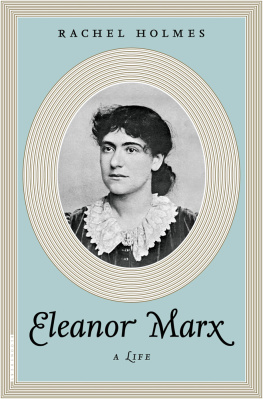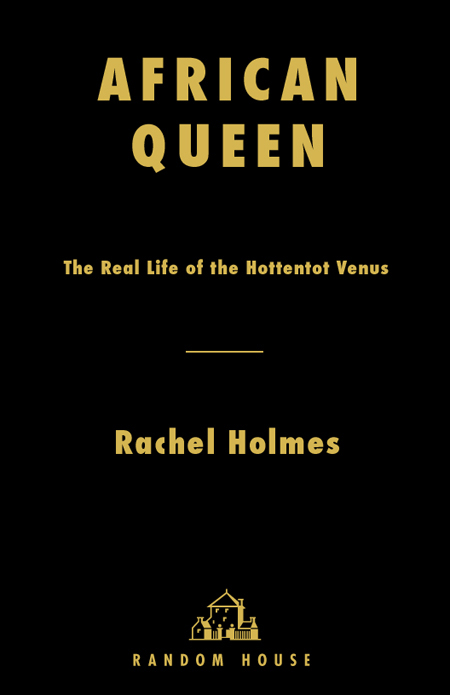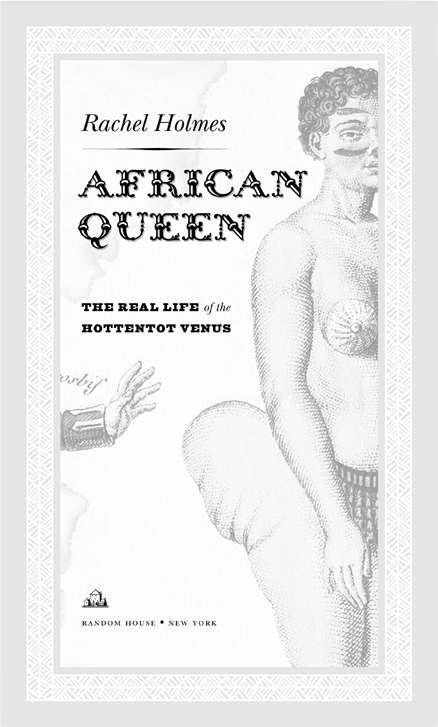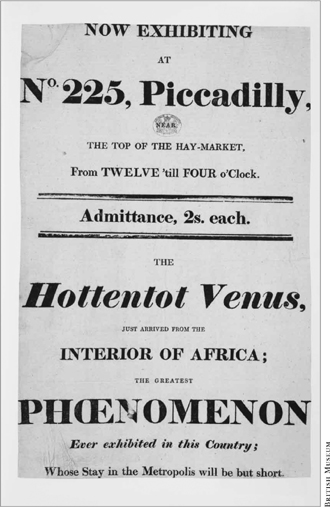Rachel Holmes - African Queen: The Real Life of the Hottentot Venus
Here you can read online Rachel Holmes - African Queen: The Real Life of the Hottentot Venus full text of the book (entire story) in english for free. Download pdf and epub, get meaning, cover and reviews about this ebook. year: 2009, publisher: Random House Publishing Group, genre: Non-fiction. Description of the work, (preface) as well as reviews are available. Best literature library LitArk.com created for fans of good reading and offers a wide selection of genres:
Romance novel
Science fiction
Adventure
Detective
Science
History
Home and family
Prose
Art
Politics
Computer
Non-fiction
Religion
Business
Children
Humor
Choose a favorite category and find really read worthwhile books. Enjoy immersion in the world of imagination, feel the emotions of the characters or learn something new for yourself, make an fascinating discovery.

- Book:African Queen: The Real Life of the Hottentot Venus
- Author:
- Publisher:Random House Publishing Group
- Genre:
- Year:2009
- Rating:5 / 5
- Favourites:Add to favourites
- Your mark:
African Queen: The Real Life of the Hottentot Venus: summary, description and annotation
We offer to read an annotation, description, summary or preface (depends on what the author of the book "African Queen: The Real Life of the Hottentot Venus" wrote himself). If you haven't found the necessary information about the book — write in the comments, we will try to find it.
Born into a herding tribe known as the Eastern Cape Khoisan, Saartjie was barely out of her teens when she was orphaned and widowed by colonial war and forced aboard a ship bound for England. A pair of clever, unscrupulous showmen dressed her up in a body stocking with a suggestive fringe and put her on the London stage as a specimen of African beauty and sexuality. The Hottentot Venus was an overnight sensation.
But celebrity brought unexpected consequences. Abolitionists initiated a lawsuit to win Saartjies freedom, a case that electrified the English public. In Paris, a team of scientists subjected her to a humiliating public inspection as they probed the mystery of her sexual allure. Stared at, stripped, pinched, painted, worshipped, and ridiculed, Saartjie came to symbolize the erotic obsession at the heart of colonialism. But beneath the costumes and the glare of publicity, this young Khoisan woman was a person who had been torn from her own culture and sacrificed to the whims of fashionable Europe.
Nearly two centuries after her death, Saartjie made headlines once again when Nelson Mandela launched a campaign to have her remains returned to the land of her birth. In this brilliant, vividly written book, Rachel Holmes traces the full arc of Saartjies extraordinary storya story of race, eros, oppression, and fame that resonates powerfully today.
Rachel Holmes: author's other books
Who wrote African Queen: The Real Life of the Hottentot Venus? Find out the surname, the name of the author of the book and a list of all author's works by series.
















 AARTJIE B AARTMAN , stage name the Hottentot Venus, emerged from behind a crimson velvet curtain, stepped out onto the three-foot-high stage in pointed green ribboned slippers, and surveyed her audience with a bold stare. Her high cheekbones and dramatic greasepaint and soot makeup gave her a prophetic, enigmatic look. Smoke coiled upwards from the pipe firmly gripped in the corner of her perfect Cupid's-bow mouth, drawing attention to her dimpled cheeks and heart-shaped face. It was a damp autumnal afternoon in London, 1810, and Saartjie was a long, long way from home.
AARTJIE B AARTMAN , stage name the Hottentot Venus, emerged from behind a crimson velvet curtain, stepped out onto the three-foot-high stage in pointed green ribboned slippers, and surveyed her audience with a bold stare. Her high cheekbones and dramatic greasepaint and soot makeup gave her a prophetic, enigmatic look. Smoke coiled upwards from the pipe firmly gripped in the corner of her perfect Cupid's-bow mouth, drawing attention to her dimpled cheeks and heart-shaped face. It was a damp autumnal afternoon in London, 1810, and Saartjie was a long, long way from home.